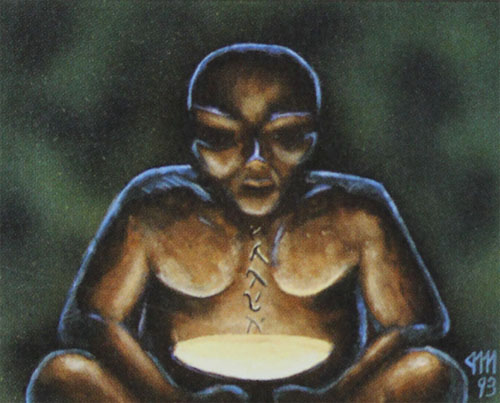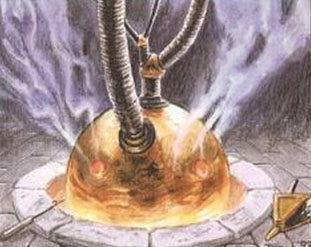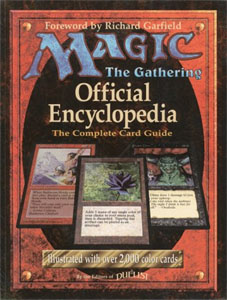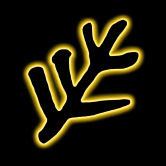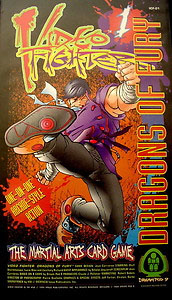 Tagline: A visually stunning, clever game… which is also overly complicated and of questionable purpose.
Tagline: A visually stunning, clever game… which is also overly complicated and of questionable purpose.
I was of two minds over reviewing Video Fighter. It is a product which is long out of print – dating back five years to a time when Dream Pod 9 was still just a design studio at Ianus Publications. On the other hand I did just pick it up (new) yesterday, so I have firsthand experience that it’s still sitting on game shelves in some places.
But what really sealed this review’s existence was when I got an e-mail today accusing me of being (and I quote) “a corporate shill” for Dream Pod 9 because of my recent reviews laced with superlatives for the Heavy Gear game. You see, I was honestly disappointed with this product, despite its many positive qualities. The e-mail, combined with the fact that I had previously jested that I was on a “quest” of sorts to find a bad Dream Pod 9 product (see my review of the Heavy Gear Character Compendium), meant that I felt this review had to be done.
Video Fighter 1: Dragons of Fury is the second Card Fighter game (the first was Heavy Gear Fighter, based on the same basic system concepts and also defunct). It attempts to simulate video games like Street Fighter II and Mortal Kombat. As Jean Carrieres describes in his introduction to the 32 page instruction book, it was designed by people with a fix for these types of games… who also happen to get their chronometers cleaned at the local arcades by young kids willing and capable of “spending their last quarter” squeaking out every possible method of annihilating the competition.
Which is, of course, the first problem with this game. It’s a card game attempting to model a video game. It doesn’t try to be a fighter card game. It doesn’t take characters from your favorite video game and do something else with them. It doesn’t try to be abstract, nor does it attempt to model reality. Instead it attempts to model the gameplay of a video game.
Maybe I’m off base here, but what’s the point? I could see creating a card game which is similar to a typical video fighter game – you’d have one-on-one fights, flamboyant characters, etc. But the mechanics would be a model of actual fights. In the case of Video Fighter, on the other hand, you have a card game modeling video games which, in turn, model actual fights. It’s weird.
About the only possible utility a game like this would have is that it would allow you to play these games with a greater reliance on the strategy of combining various moves, rather than having your plans ruined because the other guy can punch buttons faster than you.
I guess if you’re into that type of thing. I, personally, think that this is about as worthwhile as a Monopoly: The Roleplaying Game which attempted to model the mechanics of the boardgame in a format which would allow you to explore the character potentials of being a shoe.
Basically if I wanted to pay a video fighter game I’d turn on the N64 or the Sony Playstation.
Back to Video Fighter. It comes packaged in a video amray (the plastic cases that rental places put the tapes in) with a beautifully illustrated insert. Inside is the aforementioned 32 page rulebook, eight fighter character cards, 108 playing cards, a reference sheet, and counters. The fine print on the back claims that these are all in “full color”, but the rulebook isn’t. Everything is beautifully illustrated by Ghislain Barbe (Dream Pod 9 is so lucky to have him).
This is a really beautiful game. Really fantastic.
Basically the game works like this:
1. All the players pick one of the fighter character cards. Each card has a name and is rated for his hits, action points, stun points, and toughness (for high, torso, and low attacks). Each character also has a selection of “moves” which they can perform.
2. Each player gets a hand of 10 action cards.
3. Play is broken into turns.
4. Whoever has the most action points is the Attacker and the other person is the Defender. So at the beginning of the turn the person with the most action points goes first and continues taking actions until his action point total has become lower than the other player’s, at which point he becomes the Attacker.
5. Attacks are initiated by playing an action card. The attack action cards each an action point cost, damage done, stun, a color, and also a symbol which identifies it as a specific type of attack (such as a punch or a kick). Okay? Now you need to match the symbol and the color to one of the moves printed on your character card. The moves will, themselves, modify the action point cost, damage done, and stun of the action card. There are also tricks which can be played with each move. The colors also determine whether the attack is aiming high, at the torso, or low.
6. You can defend against an attack by playing a blue card. Defense action cards block against either high, torso, low, or all attacks – obviously your defense card has to defend against the appropriate location from which the attack is originating.
7. If an attack hits, you subtract the toughness (from the appropriate location) from the damage done. If you lose all your hits you lose. If you lose all your stun points you can’t take any more actions for the rest of the turn.
8. A turn ends when all of the action points for both characters have been expended. New cards are dealt to bring each hand back up to 10 cards and play continues until someone is defeated.
Phew. That gameplay, in my opinion, is about as complicated as I want to get. Unfortunately there’s far more to this game. There are Trumps. The Tricks take up an entire section of the rulebook by themselves. The possible combinations between moves and action cards and defense options (only one of the many defense options is listed above) are dizzying. Then there are the optional range rules. Heck, there are even exceptions and clarifications to the initiative rules. Plus the rulebook, defying Dream Pod 9’s subsequent record, isn’t organized effectively. Nor are the concepts clearly explained.
Argh!
This is one of those games, I realized, that you get together with a group of your friends and spend about six hours playing (with the rulebook always close at hand) until you’ve finally gotten a fairly firm grasp of the rules… and then you never play it again because by the next morning you’ve forgotten how to play the damn thing and who wants to go through the hassle of learning it again?
Here’s the catch though: It’s fun. I found the gameplay to be fairly snappy once we finally got over the steep learning curve; the initiative system was fun and very effective; even the strategies you could build once you began to get a feel for the various combinations of moves and cards were interesting.
Okay, the sum up: It’s fun. It’s also more complicated than it needs to be (my friends and I both agreed that if we ever play it again we’ll cut a lot of the needless complication and write up a cheat sheet to help us get over the poor quality of the instruction manual). Plus my friends and I still think that the general purpose of this game (to model video fighter games) is questionable – quite a bit of the excess baggage we plan to trim comes in the form of rules attempting to get the card game to behave more like its video equivalents.
Personally I’d suggest picking up Heavy Gear Fighter over this game. It has similar mechanics, but doesn’t share all of the same flaws.
So there you have it: Dream Pod 9 was capable of producing a product I was less than happy with. Of course, it was five years ago. And it’s still visually pretty cool. And the gameplay is quite good once you get through the complicated learning curve. Sure, it’s still above average. Sure, you’ll probably still find me pulling it out from time to time to play. It just wasn’t up to the Pod’s normal quality level. I’ll still be buying their stuff sight unseen – assured of their quality before the book ever leaves the shelf.
(Okay, so maybe this won’t entirely satisfy that anonymous e-mail writer. Tough.)
[ Video Fighter 1: Dragons of Fury was originally, as the numeral in the title might suggest, supposed to be the first in a series of Video Fighter products. This was called the “Wolf” deck (Wolf being one the characters in the game), with decks specialized to the other characters coming later. These sequels never appeared and Dream Pod 9 has now abandoned both Video Fighter and the entire Card Fighter line. ]
Style: 5
Substance: 3
Author: Jean “Mr. Chun Li” Carrieres with Alexandre Racine
Company/Publisher: Dream Pod 9
Cost: $29.95
ISBN: 2-921-573-20-2
Originally Posted: 1999/05/28
I knew the word “amray” because I was working at Hollywood Video when I wrote this review. As the defunct nature of that particular business might suggest — along with the references to the N64 and Sony Playstation-sans-numeral — it’s been a long, long time since I wrote these things. Since then I’ve found quite a few Dream Pod 9 products I’ve been unhappy with, but my opinion of Video Fighter hasn’t changed: It spends too much time aping one medium within the constrictions of another. Shortly after this, Cheapass Games would release the superb Brawl card game which similarly approached the “fighter” genre. But whereas Video Fighter spent its time trying to model a video game, James Ernest’s Brawl instead captured the furious intensity of a fighting game using mechanics which are uniquely suited for the tabletop.
If you ever want to be a game designer, I recommend comparing Video Fighter and Brawl side-by-side until you fully, completely, and utterly grok the difference.
For an explanation of where these reviews came from and why you can no longer find them at RPGNet, click here.

